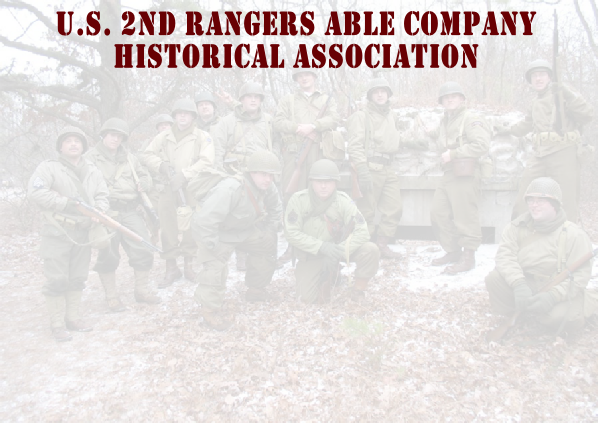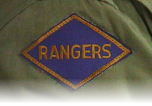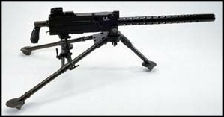
















Entire website and contents are copyright ©2016 2nd Rangers Able Company Historical
Association all rights reserved.










M1903 Springfield - .30-06 Cal.
The M1903 rifle, also known as the Springfield, began production in 1903. Through
the 1930s the Springfield was the sole long rifle of the US Armed Forces. Officially
the rifle was rendered obsolete with the adoption of the M-1 rifle in 1936, but were
used until the end of WWII. At least one per squad was issued for firing rifle grenades,
and in 1943 a special sniper version appeared, the M1903A4. The design was a variation
of the new German Mauser type 98 rifle, and was the first rifle in US Army service
to use 5-round stripperclips for reloading.
M-1 Garand - .30-06 Cal.
Named after it's designer J.C. Garand, it was a true revolution in firepower. It
was also the first gas operated semi-automatic rifle issued on a large scale by any
army. It was adopted by the US Army in 1936. Since the M-1 was only available in
limited quantities most troops were still equipped with the M1903A rifle during America’s
entrance into WWII on December 7, 1941. That would change dramatically in the following
months, by mid 1942 most troops were equipped with the M-1. The M-1 uses an 8 round,
top fed clip. After firing the last round the clip is ejected automatically, giving
a distinctive "plink". The rifle could fire as fast as you could pull the trigger,
giving the shooter a huge advantage over the enemy, who was still equipped with a
bolt action rifle. During WWII more than 5 million M-1's were made by 2 companies:
Springfield Armory and Winchester Repeating Arms.

M-1 Carbine - .30 Carbine Cal.
Designed by the Winchester Repeating Arms Company in 1941. The weapon fired a .30
pistol round and had a detachable 15-round magazine. It was intended as a replacement
for the .45 pistol and not as a light version of the M-1 Rifle. Between 1941 and
1945 more than 6 million Carbines were built by 10 manufacturers: Winchester, Inland,
Underwood-Elliot-Fisher, Rock-Ola, Quality Hardware, National Postal Meter, Irwin-Pedersen,
Standard Products, IBM, and Saginaw. Post-WWII versions were the selectable semi-
and fully automatic M2 and the sniper's version M3. The M2 & M3s used a 30-round
"banana" magazine.
M1918A2 Browning
Automatic Rifle – BAR - .30-06 Cal.
The M1918A2 Browning Automatic Rifle - BAR was the WWII version of the M1918 BAR,
used at the end of WWI. The M1918 had a wooden butt, a long wooden hand guard, no
provision for a bi-pod, a fully blued finish and the same rear sight as used on the
M1917 US Enfield rifle. The M1918A2 used during WWII had a black or brown Bakelite
butt, a simplified and smaller hand guard, a provision for a bi-pod, and a foldable
shoulder support in the butt. It featured the same rear sight as the M1919 .30 cal.
machine gun. The overall finish was parkerized. It had a selector switch to select
2 rates of fire: 500 or 200 rpm., but it didn't have a single-shot mode. It was loaded
by a 20-round, box style, magazine.

Browning Light Machine Gun - .30 Cal.
The M1919 is an air-cooled version of the standard U.S. machine gun of World War I, the Browning M1917, as designed by John M. Browning. The weapon fired the .30-06 M1 or M2 rifle cartridge from woven cloth or metalic link belts feeding from from left to right.
Loading was accomplished by opening the top cover, lifting the extractor, inserting the new belt of ammunition into the gun's feed tray, then lowering the extractor over the first round in the belt. As an infantry weapon, it was operated by 2 soldiers: the gunner, who carried the tripod and ammunition; and the assistant gunner, who carried the weapon, spare parts, and sometimes more ammunition and when in action, fed the ammunition belts into the gun to ensure smooth entry of each round in the belt, decreasing the chance of the weapon jamming.
The M1919 weighed approximately 31 pounds. Its version varied from use with a tripod or a bipod with a shoulder peice for infantry use, or a fixed mount widely used on such vehicles as: jeeps, tanks, and ships.
The A5 was an adaptation of the A4 with a forward mounting point to allow it to be mounted in tanks and armored cars. This, along with the Browning M2 .50 cal. machine gun, was the most common secondary armament during WWII for the Allies.
The M1919 was manufactured during WWII by many different companies in the U.S. including General Motors and Rock Island Arsenal.
Thompson Submachine Gun - .45 Cal.
Produced by Auto-Ordnance in Bridgeport, Connecticut, and by Savage in Utica, New
York. Army procurement records indicate Auto-Ordnance produced 847,991 guns while
Savage produced 539,143. Serial numbers of Auto-Ordnance manufacture are preceded
by "AO." The Savage productions had the letter "S" preceding serial numbers. Most
military production guns were fed by a 20 round box magazine.
The Thompson was most
popular among specialized troops such as Rangers and Airborne units. Thompson’s were
produced in a number of models; M1921, 1923, 1927 & 1928’s varying in length, sight
styles, bolt locations, foregrip styles, etc. Although the Thompson had many good
attributes and enjoyed a good reputation, it did have drawbacks. One of the most
frequent "gripes" was its weight of more than 10 pounds; heavier than the M1 Garand.
M3 SMG Greasegun - .45 Cal.
A cheap replacement for the Thompson SMG. It was made of stamped metal parts, and
its tube-like appearance gave it the nickname "greasegun". The M3 had a cranking
handle, where the M3A1 had a hole in the bolt itself so it could be cocked with a
finger . The ejection port cover doubled as a safety, when closed the weapon could
not fire. Some M3's were issued just before D-Day; these early examples have a simple
L-shaped rear sight. All WW2 M3's were made by Guide. The weapon was never very popular
with the troops, because of poor accuracy.
Model 1911 Pistol - .45 Cal.
The Colt model 1911 was the standard sidearm in the US Armed Forces from 1911 until
the 1980's. The pistol carried a 7 round magazine. During WWII the “45” was made
by Colt, Remington, Springfield, Burroughs, Savage and several other manufacturers.
From 1911 until the 1980's it was typically carried in the same M1916 russet leather
holster, although the color was changed from natural brown to black in the late 1940's.
All have the large "US" symbol stamped at the flap and WWII dated holsters can be
found dyed black.
The M3 Knife:
The M3 is marked on the blade (early production), or on the hand guard (late production).
All had the 8-groove leather handle. These knives were a general issue item, although
best known as strapped to a paratrooper's leg. The knife could be carried in the
leather M6 -, the M8 - and the M8A1 scabbard. The M8 scabbard was made from July
1943 until April 1944. The M8A1 was in production from April 1944 until well in the
1980's and was also used for other types of knives and bayonets. The M8 scabbard
lacked the wire hanger, and could only be worn with the pistol belt. The M8A1 scabbard
did have this hanger, and most M8's were modified to the M8A1 specification.
The Trenchknife:
Used in WWI and came out of storage again during WWII, when they were issued on a
small scale to Ranger and Airborne troops. The striking feature of this knife is
of course the knuckle-duster.
The Bayonet:
Used for both the M1903 and the M1 rifle. The type M1905 with a 16" blade, was originally
used in WWI. The stock of existing M1905 bayonets was used up in around 1941, and
a contract for a batch of newly produced M1905's was issued in 1942. These newly
produced bayonets were updated with the new black plastic grips, and although they
were never given an official nomenclature these are generally known as the "M1942"
type because they were dated 1942 on the blade. The older M1905 bayonets were also
overhauled to the new M1942 specification. It became obvious soon that the long 16"
blade of the M1905/M1942 was a burden, and in early 1943 a new contract was issued
for an M1942 bayonet with a 10" blade. This new model was adopted as the M1 bayonet
in 1943. At the same time an order was issued to cut down all the 16" M1942 bayonets
to the new 10" specification. These cut-down M1942's are known as the M1905E1.
MK2 Hand Grenade
One of the most famous and recognized hand grenades of WWII. It is commonly known
as the "Pineapple", which refers to the shape and sections of the cast iron body.
Its effectiveness is based on shrapnel rather than blast force, and has a radius
of about 30 feet. The explosive inside is TNT. Pre-1942 examples have a yellow painted
body, and a lead plug in the bottom. Post 1942 made examples are painted OD with
a yellow band around the top of the body, and had a solid bottom. A special launcher
was used to launch the grenade from a standard M1 rifle or M1903A Springfield. The
launcher would be clipped to the barrel of the rifle and the grenade would be launched
by using a special cartridge.










